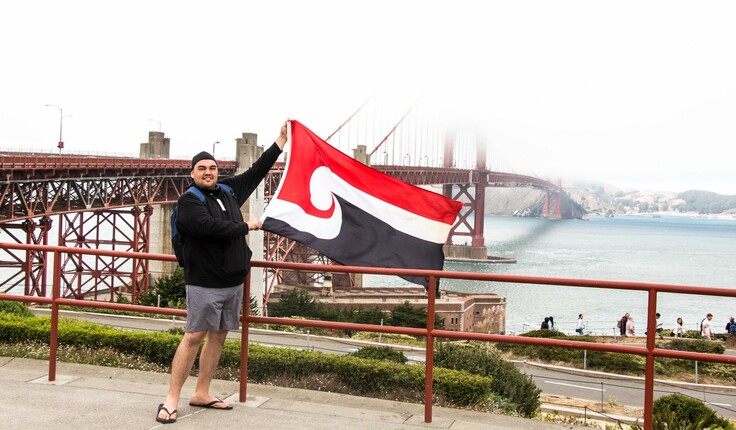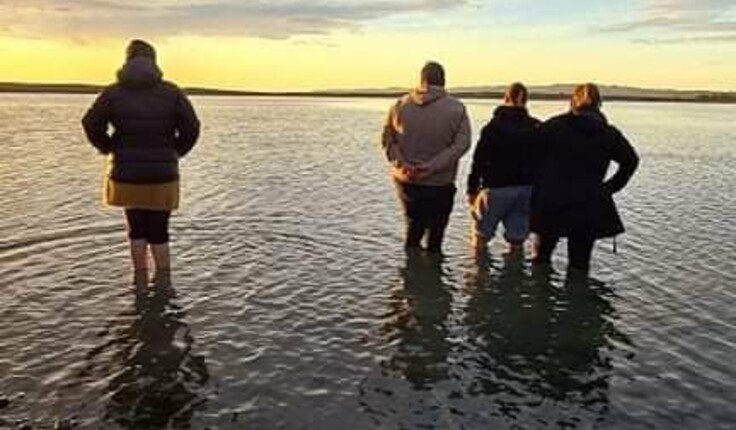News
The future of 'Landscapes of Aotearoa.'
Posted 06 09 2021
in News

One of the hats William Hatton wears proudly is as a tutor at Unitec teaching ‘The Landscapes of Aotearoa’ course. LAA has run a series of essays by some of the students. Here Hatton reflects on their work and the course.
E tipu e rea mo ngā rā o tō ao.
Ko tō ringa ki ngā rākau ā te Pākehā hei ara mō tō tinana,
Ko tō ngākau ki ngā tāonga a ō tīpuna Māori hei tikitiki mō tō māhuna,
Ko tō wairua ki tō Atua nānā nei ngā mea katoa.
Ka mihi ki te Atua i runga rawa.
Ka mihi ki a Ranginui, Te Hau e pāngia ngā kiri o te tangata.
Ka mihi ki a Papatūānuku, Te Ūkaipō, Te Ūkaiao o tātou katoa.
E ngā mate, haere ki ngā tini whetū o te rangi, moe mai ra.
E ngā mana, e ngā reo, e ngā rau rangatira ma, tēnā kōutou kātoa.
Ka timata tēnei kōrero i tē whakatauakī nā Tā Apirana Ngata ki te tautoko tēnei tuhi.
Nōreira, kō wai au?
Ko au te whenua, ko te whenua ko au.
No Te Mahia mai Tawhiti ki te raki, mai Te Tau Ihu o Te Waka-a-Māui ki te tonga, mai ki Himatangi ki te uru me ngā whenua i waenganui mai ki takutai ki tai.

He uri ahau no Ngāti Kahungunu, Ngāti Rongomaiwahine, Ngāti Raukawa ki Te Tonga, Rangitāne me Muaūpoko hoki.
I tipu ake au i raro i te maru o Te Mata o Rongokako, engari, e noho ana ahau ki Tāmaki Herenga Waka, Tāmaki Herenga Tangata i naia nei.
He Kaiawhina Whenua Māori me Kāiako Kaiawhina Whenua Māori hoki ahau.
Nōreira, ko au tēnei!
The land is what makes us unique as tangata whenua and tangata tiriti. It is the land that provides the knowledge, stories and tools to create and bring life into the places we live. Growing up in a Māori and Pākehā environment, I’ve been fortunate enough to understand both in parallel with one another, and the importance of Māori identity.
Our definition of landscape architecture is defined as everything outside, urban and rural, and at the interface between people and the natural systems. This is not an unknown or new concept here in Aotearoa. It is rather one that we are reclaiming and unlocking. For Māori understanding the intricate patterns, flows and changes of Te Ao Tūkupu (universe), have always informed the way we live harmoniously within our environments.
Over the past month, three tauira (students) have provided their own personal perspectives into the Landscapes of Aotearoa course at Unitec. This course explores the evolution of tangata (people) and whenua (landscapes) in Aotearoa through a Te Ao Māori lens – understanding our identity, our histories, and our stories. The course was broken into three components – the past, the present and the future, allowing tauira to engage, to become aware and to become comfortable in exploring and expressing Te Ao Māori values, principles, and design.
The past component to the course explores the creation stories, pepeha, whakapapa, He Whakapūtanga, Te Tiriti o Waitangi, colonisation, raupatu (Māori land confiscations), Māori land wars, Treaty Settlements, and the shifts of Māori culture and identity. The present explores the revitalisation of Māori through language, culture, and customs. Lastly, the future explores the application of Te Ao Māori through design – architecture, urban design, landscape architecture; where, we as tangata whenua and tangata tiriti come together to create our own unique sense of place - tūrangawaewae.
Whilst moments of the course may have been uncomfortable and sometimes heavy to take in, it is important to understand this history. To be comfortable as designers in Aotearoa, we need to become uncomfortable, acknowledging and understanding our past. Whilst there are moments in time that have heavily impacted Māori, we need to understand these to help us reconnect to our landscape. Whilst western systems allow us to understand the practicalities of what landscape architecture is, we need to equally, if not prioritise, Te Ao Māori. The knowledge and values embedded within allow us to unlock the connections we share with the land, and furthermore, how we read, understand, and design within our environments. The course provides tools of engaging, communicating and exploring Te Ao Māori.
One of the assignments of the course was to discuss how differing ‘world views’ influence the practice of landscape architecture in Aotearoa capturing our personal, western and Māori world views.
Yue Zhang shared her views around understanding the core differences between indigenous worldviews and western worldviews. In doing so she saw that we can achieve cultural harmony and respectful relationships through design. “This course has demonstrated how colonisation has, for a time, monopolised architectural influence in Aotearoa. I am encouraged to see this trend turning around with a focus on indigenous cultural influences – Te Ao Māori”.
Jessica Tregidga shared her views about creating impactful and unified spaces, understanding people and land cultivated through a Te Ao Māori lens. “This course has developed my knowledge far beyond what I knew. It has given me a deeper insight and perspective into our culture and am very grateful for it, as it has allowed me to have this conversation and go more in depth into a topic that is not discussed enough.”
Lastly, Drisana Brown shared her passion for designing from a grassroots perspective understanding the land, people and stories – for that is our culture. “Through education we can be freed from thinking about individualism and greed, but rather spiritual principles of generosity and justice. When nurtured with the right education it will influence the younger generations to contribute to the betterment of their community spiritually, intellectually and physically.”
When hearing the voices of our tauira, I am reminded of a saying from one of our kaumatua, Haare Williams, “that we are all students of life”. No matter our age or position(s) we hold, we are constantly learning across time and space. Last year’s course lecturer, Jacqueline Paul (Ngāpuhi, Ngāti Tūwharetoa, Ngāti Kahungunu ki Heretaunga) sought the importance of voicing our tauira perspectives. “As an industry, we often forget the power and importance of our future leaders. By giving our tauira the opportunity to share their worldviews about landscape architecture, they provide us with the tools to better grow and upskill our capability and capacity required for the future”.
Being able to facilitate this course, has allowed tauira to see Māori take up their rightful place to educate and communicate the importance of culture, from our own and at most times personally lived experiences. It is about connecting with our past and acknowledging how far we have come as a nation, upholding the works of our tūpuna (ancestors) and recognising our obligations under Te Tiriti through partnership, participation, and protection. Whilst I do not consider myself a mātauranga Māori expert, it is our duty as tangata whenua to rightfully claim these spaces to ensure our culture and history is expressed by our own.
Important attributes from this course, allow tauira to understand the importance of mana (authority) and rangatiratanga (partnerships and relationships). We are currently in a time and age where Māori are reclaiming their position at the decision-making table, which is evident in the works we do. We are now beginning to work more collaboratively with tangata whenua through a kaupapa Māori process, listening, learning and overall enhancing mana and mauri through our designs.
Although we are seeing a shift across practice and education, we continue to prioritise western systems and thinking over the importance of our own distinct language and culture. Being one of very few Māori practitioners, who again, very rarely sit across education as well, I have been able to see how both practice and education perceive and connect with Te Ao Māori and with one another.
The conference held in Tauranga earlier this year, explored the theme ‘Te Rangitamiro – Radical Reorientation’ which sought out current issues like decolonisation and how design can respond to these issues. As Henry Crothers expressed, “the discussions highlight the opportunities we have as landscape architects to understand those issues and how we can contribute to solutions given the breadth of the work we do.” One way we can respond and design with this, is by re-educating ourselves within the landscapes of Aotearoa, reconnecting with the important layers associated to Te Ao Māori.
In 2022, Tuia Pito Ora New Zealand Institute of Landscape Architects, will celebrate 50 years as an industry. If we are to reflect on our past and see what the future holds across practice and education, let us question, what does the future of ‘Landscapes of Aotearoa’ look like?
Kua takoto te mānuka – the challenge has been laid.
Share
19 Dec
Christmas break 2025

see you from 12 January
As we wrap up another big year, we’re taking a moment to pause, breathe, and enjoy a well-earned break. Meri …
18 Dec
President’s update

December 2025
Earlier this month I attended the Ngā Aho Māori Design Professionals Wānanga-ā-Tau at Te Aranga Marae in Flaxmere. Tuia Pito …
18 Dec
Awards 2026 update

An update as we warm up for the 2026 Awards kaupapa. Submissions will open in March and will run for …
Events calendar
Full 2025 calendar